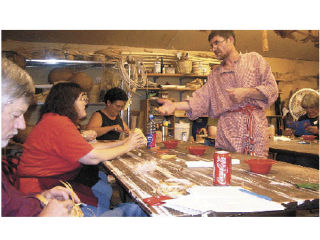Like many cultures around the world, Russians, too, have used baskets made of natural materials for all kinds of uses. Like Pacific Northwest Natives, Russians traditionally made baskets that could even hold water.
One of Russia’s renowned basket makers of modern day, Vladimir Yarish taught a two-day workshop in Marysville recently. He came from Veliky, Novgorod to be one of 15 teachers at the biggest basketweaver convention in the U.S., the Michigan Basket Weaver’s Convention, and then he came to Marysville teach the students of Judy Zugish.
Basket makers came from around Puget Sound to learn his special techniques.
Yarish brought with him all the materials required to teach the class, with no problems with customs, he said.
“Even President Bush or Condoleeza Rice could not stop me from coming,” he laughed.
Yarish specializes in baskets made of Russian birch, which is a whole different world than other birches, Yarish told the group of about 15 basketmakers, mostly members of the Northwest Basketweavers Guild.
The Russian baskets can hold milk and sour cream, salt, cucumbers, honey and berries. But not bread, said Yarish. Due to the moisture in the natural bark, it is not appropriate for storing bread, he explained.
The baskets assume many different shapes and sizes, from pure cylinders to the delicate shape of a swan. “The grain keepers are more sculptural,” Yarish said, adding that baskets are still being used in villages of Russia.
While the bodies of the baskets are made of birch bark, decorative features can be added with an assortment of other materials, like spruce roots for edging and Linden tree wood for the tops.
This was Yarish’s seventh trip to the United States.
His host, Zugish has known him for 10 years.
During his visit, Zugish took Yarish on some sight-seeing adventures, across the ferry to Whidbey Island and to the Snowgoose Gallery in Seattle that features Native American art.
The participants in the workshop were regulars at the Marysville studio, where Zugish teaches a variety of basket making techniques.
Kay Ogren came from Anacortes to work with Yarish. She also attended a whole series of workshops last year that ran on alternate weekends, from October to January.
“Judy led us through the whole process, from harvesting to weaving the materials,” Ogren said.
“I’ve been experimenting with growing stuff like willow at home,” Ogren added.
Ursula Andrews came from Stanwood for the class.
“We learned about the nature of all the different kinds of materials and what each one is good for,” Andrews said about Zugish’s series.
A few of the attendees make baskets to sell, including Elaine Twogood, from Tacoma.
“I use reed and rattan for the baskets I sell, but I like to explore different materials and styles,” Twogood said.
Zugish said she planned almost two years ahead to get Yarish to come to her studio. Normally she teaches the classes herself, but couldn’t resist this opportunity.
At her nursery hidden in the heart of Marysville between State Avenue, the railroad tracks and I-5, she feels the crunch of growth.
“Things keep changing,” she said. “My strategy is to embrace the fluidity and make peace with all the changes.”
Through the years in her secret garden she has grown basil, lilies and sweet peas, but is now focussing on materials that make good baskets.
Vladimir Yarish is one of three authors, with Flo Hoppe and Jim Widess, of a book due out soon, “Plaited Basketry with Birch Bark,” that includes a history of Russian birch bark work, with sections on tools, weaving directions and 18 different projects. For information e-mail to Yarish1@yandex.ru.








